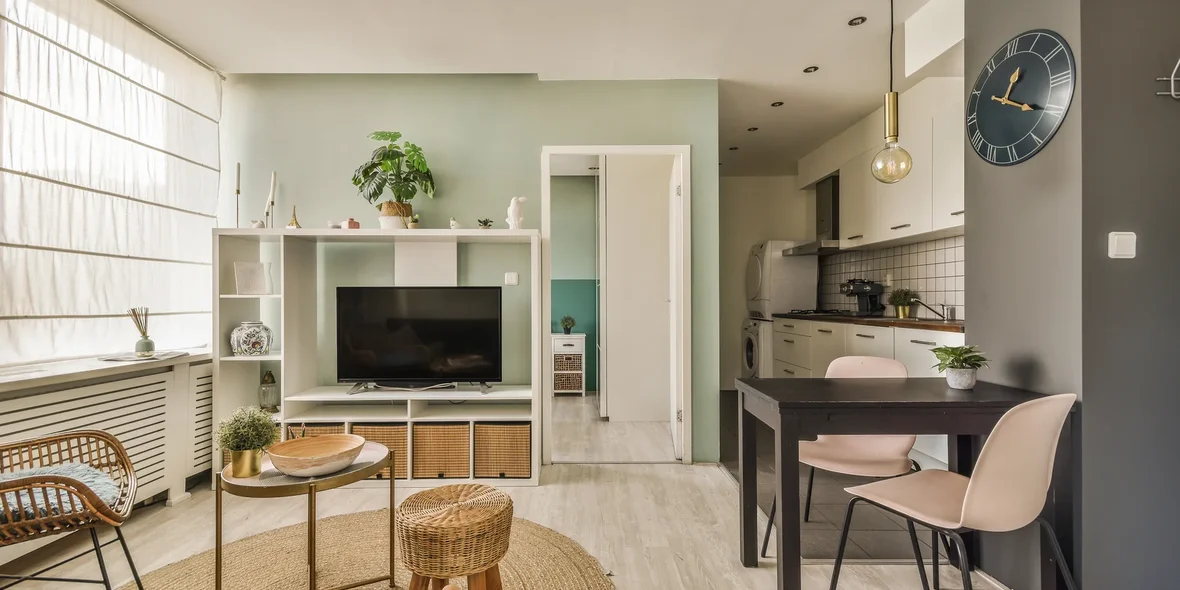
How to Turn a Small Apartment into a Cozy and Functional Space
Residential property prices rise every year, and unfortunately, incomes don’t always keep up. This reduces housing affordability and, consequently, demand. Developers aren’t thrilled with this situation because they risk not only their construction investments but also their reputation, after all. Few want to work with a company that can’t sell its own properties.
To avoid this, developers increase the number of one-bedroom and studio apartments in new projects. These units are cheaper and in higher demand, but what can buyers do? The answer is simple: optimize the available space to fit modern needs. In this article, we’ll explore contemporary space-saving solutions for small apartments — keeping walkways clear while ensuring comfortable living.
Studios vs. Apartments: Key Differences
Initially, apartments and houses were distinguished solely by the number of rooms, with the smallest unit being a one-bedroom apartment (30–45 m²). However, soaring land prices in major cities forced the real estate market to introduce a new housing type: studios. These are even smaller (20–35 m²) and consist of a single open space where the kitchen, bedroom, and living area merge. Zones are only loosely defined, separated by furniture, lighting, or screens.
But that wasn’t enough. Some large markets took it further, introducing micro-apartments (10–20 m²). These ultra-compact units are primarily relevant in megacities, where every square centimeter counts, and any smart solution is a plus.
Space Optimization in Small Apartments
To make a studio or small apartment functional and cozy, you need smart tactics for using every inch of space — starting with the walls. They’re your greatest ally in optimization. Install shelves, hooks, and holders to store books, kitchenware, and more without cluttering the floor.
Other space-saving strategies:
- Multifunctional furniture. Choose pieces that serve multiple roles: a bed with storage drawers, a sofa bed, or a foldable table. Prioritize easy-to-transform items that don’t overwhelm the interior.
- Organizing small items. Use organizers for keys, dishes, and toiletries. Drawer dividers and hanging baskets keep everything in place — like a kitchen utensil tray or a bathroom caddy.
- Unconventional storage areas. Utilize every nook: windowsills, space above doors, corners, and even under the bed. For example, a wide windowsill can double as a desk, while a corner can house a mini-wardrobe.
Mirrors and light colors can also create an illusion of spaciousness, as can strategic lighting — though, sadly, it’s just an illusion.
10 Space-Saving Solutions for Small Apartments
Now that we’ve covered the basics, here are the most creative ways to avoid clutter:
- Wall storage. In a studio, floors are precious, so walls become prime storage real estate. Floor-to-ceiling shelves or narrow racks hold books, decor, dishes, or clothes without eating up space. In the kitchen or living area, they replace bulky cabinets. Even bikes can be wall-mounted (just clean the wheels and secure them properly — especially if hanging above a sofa!). Renters can use adhesive-mounted shelves — no drilling, no damage.
- Bed with built-in storage. Beds take up significant space, so urban dwellers often opt for two solutions: lift-up beds (which fold vertically into the wall) or models with under-bed drawers. The latter turns the space beneath into a dresser for clothes, shoes, or miscellaneous items. If a storage bed isn’t in the budget, use bins under a standard bed frame.
- Hanging organizers. Ideal unless ceilings are too low. Use them in the entryway for shoe care items, in the bathroom for toiletries, or in the kitchen for rarely used dishes. They free up floor space by eliminating the need for cabinets.
- Windowsill as a shelf or desk. Don’t just use it for plants. A deep sill can become a workspace with side shelves for books. Near the kitchen? It’s a perfect prep station.
- Corner utilization. Corners are often “dead zones,” but corner shelves or cabinets can store books, cosmetics, or decor. Great for kitchens, bathrooms, and living areas. If drilling isn’t an option, freestanding corner shelves work too.
- Multi-level closets. Standard wardrobes waste lower space. A two-tier closet doubles storage: shorter items (shirts, tees) on top, longer ones (coats, dresses) below. Slimmer hangers also save room.
- Curtains as doors. Replace bulky cabinets with curtain-draped shelves. A rod in the corner can hide outerwear; in the kitchen, a curtained shelf conceals appliances or infrequently used items.
- Wheeled furniture. Mobile pieces (like a rolling TV tray) allow quick rearrangements — perfect for entertaining or freeing up space when needed.
- Above-door storage. Install shelves above doors for rarely used items (e. g., document boxes in the living room or towels in the bathroom).
- Foldable workstation. No room for a desk? A wall-mounted drop-leaf table paired with a folding chair creates a workspace that disappears after use. Add a magnetic board for office supplies.
Final Thoughts
Living comfortably in a studio or small apartment is entirely possible with smart space management. By maximizing every inch, even 20 m² can feel like home — with room for sleeping, working, relaxing, and creating. From vertical shelves to mirrors and minimalism, each solution unlocks a compact space’s potential.
Start planning early: before moving in, study the layout, walls, windows, and doorways to determine what furniture fits (and what doesn’t). For example, a bulky wardrobe in a 25 m² studio may hog too much space. Often, simply decluttering eliminates the need for extra storage altogether.
Author
I write informative articles about real estate, investments, job opportunities, taxes, etc.
























